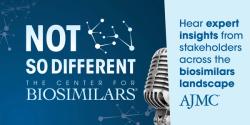© 2025 MJH Life Sciences™ and The Center for Biosimilars - Biosimilars, Health Economics & Insights. All rights reserved.
White Paper Argues Increased Competition Will Improve Biosimilar Uptake, Savings
A white paper touting biosimilar successes in the United States reasoned that increased market competition will help improve utilization rates, generate substantial savings, and encourage payers to cover biosimilars.
A white paper touting biosimilar successes in the United States reasoned that increased market competition will help improve utilization rates, generate substantial savings, and encourage payers to cover biosimilars.
“The industry continues to build on valuable learnings that will help systems be better prepared for the influx of biosimilars that are on the precipice of approval. We continue to adapt and learn from best practices that will allow us to accelerate realizing the benefits of biosimilars in the US,” wrote the authors.
The paper was penned by Bhavesh Shah, RPh, BCOP, chief pharmacy officer of hematology oncology pharmacy at Boston Medical Center; and Ryan Haumschild, PharmD, MS, MBA, director of pharmacy services at Emory Healthcare and Winship Cancer Institute. Haumschild is also an advisory board member for The Center for Biosimilars® and an editorial board member for The American Journal of Managed Care®.
Between 2010 and 2015, 70% of drug spending growth in the United States was attributed to biologics, which accounted for 43% of the $211 billion that was spent on pharmaceuticals in 2019 despite only representing about 2% of prescriptions. Estimates have predicted that biosimilars could generate upwards of $100 billion between 2021 and 2025.
Although some of the barriers to biosimilar adoption have been addressed—such as coverage—the United States still has a ways to go to realize the true extent to which biosimilar savings can be achieved. The authors theorized that if there were more biosimilar product entries, higher biosimilar volume share, and lower prices for biosimilars and reference products, savings attributed to biosimilars could be as high as $224.2 billion.
Some of the remaining barriers to biosimilar adoption are:
- Complex stakeholder relationships
- Negative perceptions of biosimilars
- Operational issues for formularies and pharmacies
- Coverage complexities
Each biosimilar undergoes complex processes for contracting, reimbursement, and policy decision-making, and biosimilar preferences can differ between prescribers and payers, creating a lack of consistency across the board. Prescribers may also have different perceptions of biosimilars compared with patients. Evolving inventory management procedures for biosimilars could help address concerns regarding stocking, storage, creating new orders, and safety alerts, especially when having to manage multiple biosimilars for the same reference product.
It can also be difficult for clinic personnel and pharmacists to track electronic health record changes and substitution statuses. Coverage and reimbursement policies can vary between payers, as can patient support programs offered by manufacturers, which can complicate patient and provider navigation of biosimilar options.
Increased competition between manufacturers has the potential to encourage a higher focus on drug formation practices, supply reliability, lowered costs, more focus on patient support and access programs, continued commitment to biosimilar innovation, and a financial commitment to increasing medication access.
“As more biosimilars enter the market, manufacturers will be held to higher standards and counted on to help make adoption less difficult. Healthy competition can help drive accountability and new innovations, which could increase the quality of care while simultaneously lowering costs,” the authors noted.
Additionally, pharmacist-driven biosimilar substitution programs could help boost biosimilar adoption. The authors cited a study that assessed the utilization trends and financial impacts of implementing a substitution program, which found that utilization of pegfilgrastim biosimilars jumped from 20% to 60% during the study period, resulting in a 18% jump in savings for payers.
The authors were hopeful about the possibility of extending the biosimilar reimbursement bump laid out in the Inflation Reduction Act, saying “bipartisan support in Congress for patent reform and formulary coverage initiatives are gaining momentum. Combined, these initiatives are poised to unlock the incredible potential of biosimilars in the US.”



